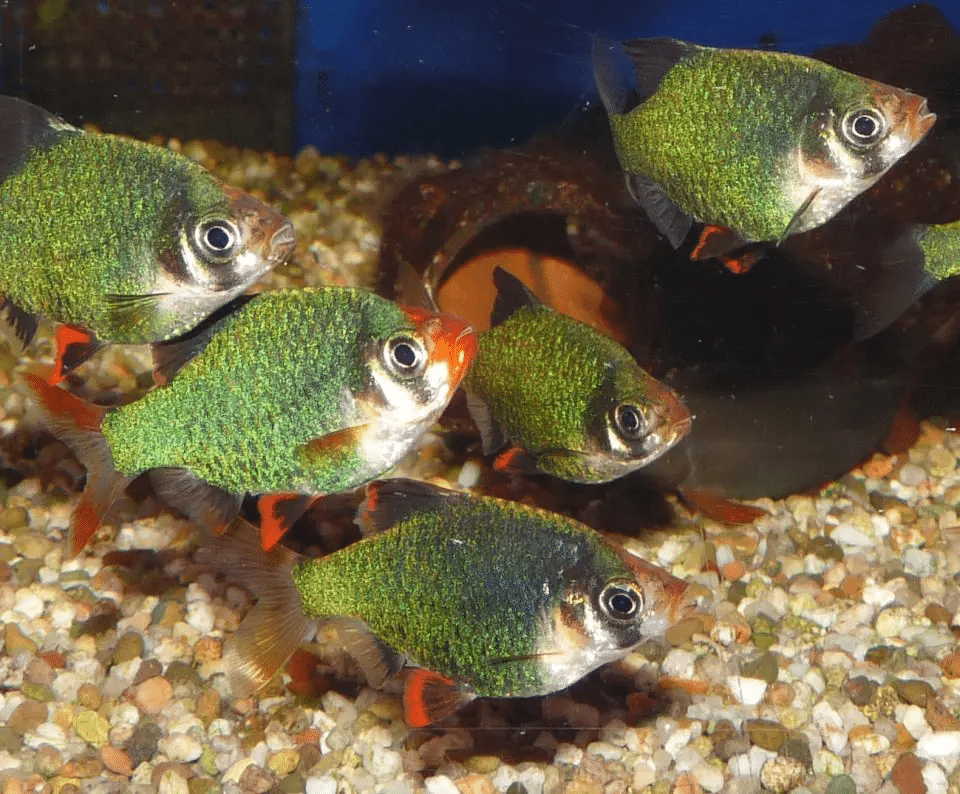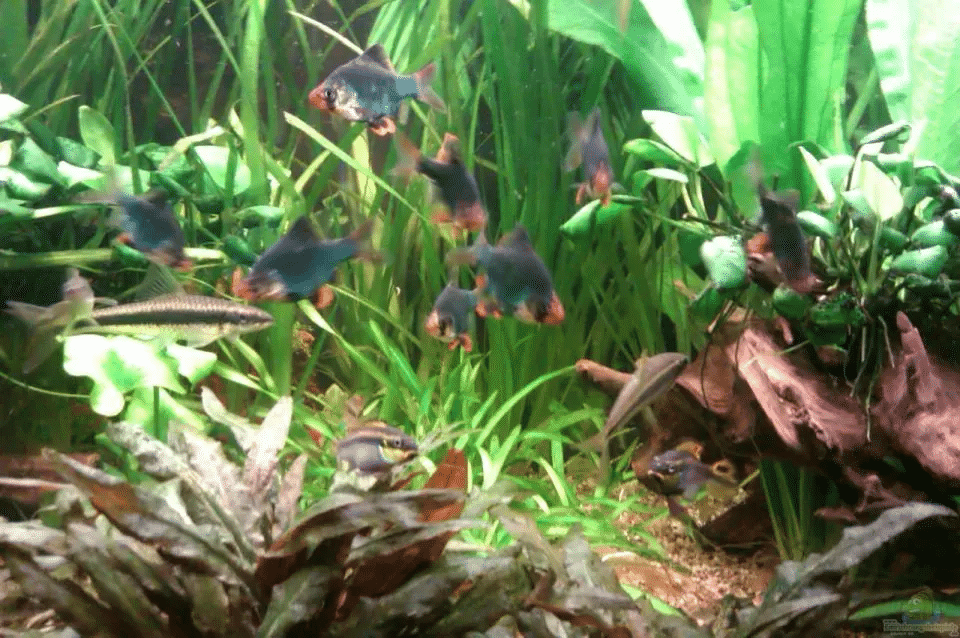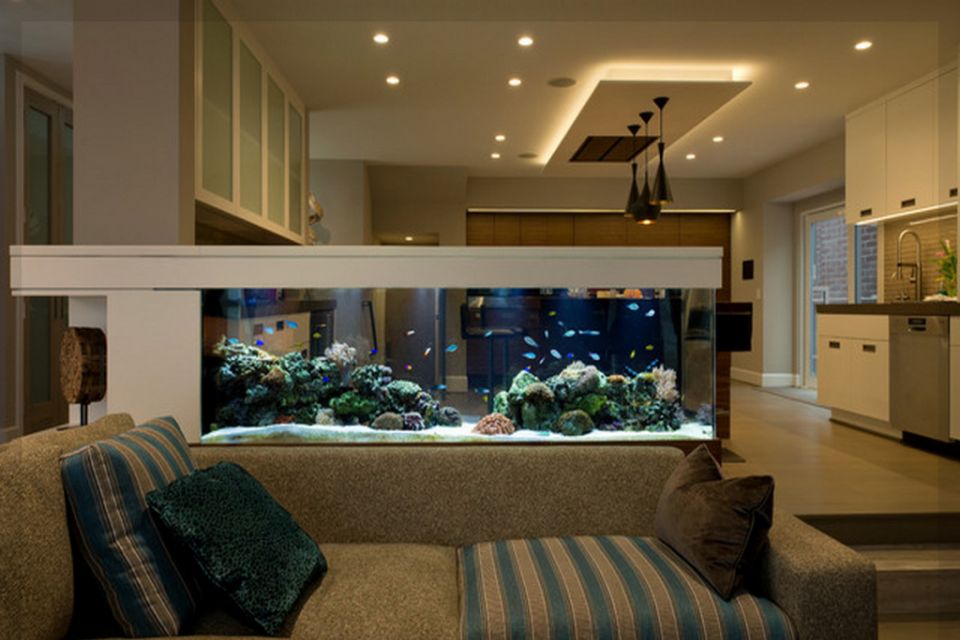
How to keep the interesting moss barbels in your aquarium, how many moss barbels you should use and how you can breed the animals, you can read in the following aquarium guide article.
Table of Contents
Everything important about moss barbs in a nutshell
- The moss barb is a green-coloured cultivated form of the Sumatran barb originating from South East Asia. It belongs to the carp family.
- Males and females reach a size between six and seven centimetres. While females are built more plump and high backed, males shine with their even more intense green colour.
- Unlike their conspecifics, Tiger barbare green throughout. The dorsal fin of males shines in a deep red, in females it looks rather pale.
- Tiger barbshould always be kept in groups of at least eight to ten animals. In this way it is possible to observe their interesting behaviour pattern closely.
- The fish possess a fascinating social behaviour. After only a short time, a leader determined by fights is chosen from among the fish.
- Tiger barbis usually a peaceful fish, but can also show a hectic behaviour.
- Moss barbels should not be socialized with long-finned fish, such as the honey gourami, because the animals tend to nibble on the fins.
- The aquarium should have an edge length of at least 80 cm, because the moss barb is quite keen to swim.
- The fish feel comfortable at a temperature of 22-26° Celsius. The water of the aquarium should have a pH value of 6.0-7.5 and a total hardness of 5-19° dGH.
- Tiger barbprefer the middle layer of water, which is why border and background planting is perfectly adequate. Vallisneria, for example, are recommended for this purpose.
- The small carp fish can be fed with commercial ornamental food.
- The breeding of the moss barbels is simple and takes place in a separate tank. However, the parents must be removed immediately after laying the eggs, otherwise they will eat their own offspring.

Where do moss barbs occur?
Tiger barb are a cultivated form of the tiger barbels and are therefore not found in nature. Their relatives, however, come from Southeast Asia and prefer quiet and slow-flowing waters. There they usually live together in large flocks.
How many moss barbs do you keep in your aquarium?
Tiger barb has a distinctive social behaviour and prefers to live in larger groups. Ideally, therefore, no less than eight fish are kept in order to ensure a pleasant coexistence.
For keeping the moss barb in the aquarium it is also very important to provide a sufficiently large aquarium. This should have an edge length of at least 80 cm, because the swimming-joyful animals need much place. If this swimming area is not available, the animals feel quite fast unwell and often fail.

How are moss barbs kept in an aquarium?
Moss barbs prefer pools rich in structure with a lot of space to hide. Nevertheless, the swimming area should also be large enough. Since barbels also live in the wild in densely overgrown bank zones, it is also recommended to the aquarium keeper to design the aquarium accordingly.
The swimming-joyful fish usually stay in the middle water-layer. If they pluck each other’s caudal fins, this is a sign that their habitat is too small. In order to avoid a further deterioration of the well-being of the animals, aquarists should therefore try to get a larger tank as soon as possible.

In order for Moss barbs to feel really comfortable in the aquarium, there must be sufficient retreat possibilities in the tank. Robust solitary plants, as well as bogwood roots are excellently suited for planting. Especially Vallisnerias are extremely suitable for planting, because they are known for their density and grow basically without the addition of fertilizers or Co2. They also spread quickly on the surface and provide a shady carpet.
The pool should also have a lot of structure and clearly defined areas. Here, too, the vallisnerie is a wonderful planting, stones and roots do the rest.

The ground is usually covered with dark sand. Lighting should normally follow a natural day and night cycle. In most cases fluorescent tubes or LED lights are used. When keeping moss barbs in the aquarium, it is also important to ensure that the tank is not too brightly lit and that there are different areas with different light intensities – sufficiently shaded areas are very important for the well-being of the animals.
Since Moss barbs live in calm water in nature, it is recommended to reduce the currents in the aquarium.

Which water values does a moss barb prefer?
As far as water quality is concerned, the moss barb is a relatively undemanding tank inhabitant – most German taps give out optimal water. The following water values should definitely be observed:
- Tank size: 120 litres
- Water temperature: 22-26° Celsius
- pH value: between 6,0 and 7,5
- Total hardness: 5-19° dGH
Moss barbs is a particularly swimming-joyful and frolicsome fish, why the basin should always have a size of at least 120 litres. If it is too small, the fish quickly attract attention by biting each other’s caudal fins.
Moss barbels can be kept in water with a total hardness of 5-19° dGH without any problems. If the pH value is between 6.0 and 7.5, this is also ideal for the fish. At a water temperature of 22-26° Celsius, the green beauties feel particularly well.

Company of Moss barbs
Moss barbs can be associated with different fish species. However, it must be noted that they like to chase after long-finned fish. They nibble the fins of the animals, which will lead to permanent damage. It is therefore not recommended to socialize with angelfish and fighting fish.
Similar to their close relatives, the Sumatran barbels, Moss barbs can also become somewhat rough at times, not only among each other, but also towards alien fish.
Ideally, moss barbels can be easily socialized with more robust catfish – the L333, the whiptail catfish or the feathered catfish are excellent as supplementary stocking. But also small species of loaches, such as the firetail, and other barbel species, such as the wedge-tailed bearblings are extremely well suited for moss barbels. You only have to pay attention to the same temperature preference and to keeping the water values.

What does a moss barb eat?
Moss barbs can basically be fed with the most common types of food for ornamental fish. Live and frozen food is also on the menu. For an overview of the types of aquarium fish food, please follow the link.
In addition, aquarists should not forget the green food, otherwise the aquarium plants will suffer. If you start early with a blend of different food types, you will ensure a balanced diet right from the start.
Moss barbs are particularly aggressive eaters, which is why they should be fed with care. They also have a tendency to become obese, which is why aquarists should always adjust the exact amount of food they are fed. Fasting days should definitely be observed – we have found it to be best to feed the animals only every two days.

How are Moss barbs bred?
The breeding of Moss barbs can easily be done in the aquarium. In the breeding tank the optimal water values should prevail, as described above. The water should also be soft and slightly acidic. In this case, a substrate is also not absolutely necessary.
However, the breeding tank itself should be covered. Few, finely feathered plants are sufficient for this time. On these the female lays her eggs. As moss barbs are free-spawning, the parents must be removed from the tank after laying the eggs, otherwise they will eat their own offspring. The animals hatch in the following two to three days, sometimes sooner or later.
The offspring is temporarily reared with paramecia, followed by feeding with brine shrimp.
Conclusion: Keep moss barbs in the aquarium
The pretty moss barbs can be kept as ornamental fish in aquariums without any problems. To ensure that Moss barbs really feel at home, an aquarium with at least 120 litres is recommended. As already mentioned, the planting of the aquarium should be particularly lush.
Tiger barb do not have great demands on the water, nor does keeping them require a deeper understanding of aquaristics – they are therefore also suitable for beginners.
Long-finned species such as guppies or gourami should definitely not be associated with the moss barbels, as Moss barbs tends to nibble at the long fins. However, barbels of the same temperament, as well as loach species or catfish, are suitable for socialization.
Breeding moss barbs is also easy, but should be done at all times in a separate aquarium to prevent spawning robbery.



